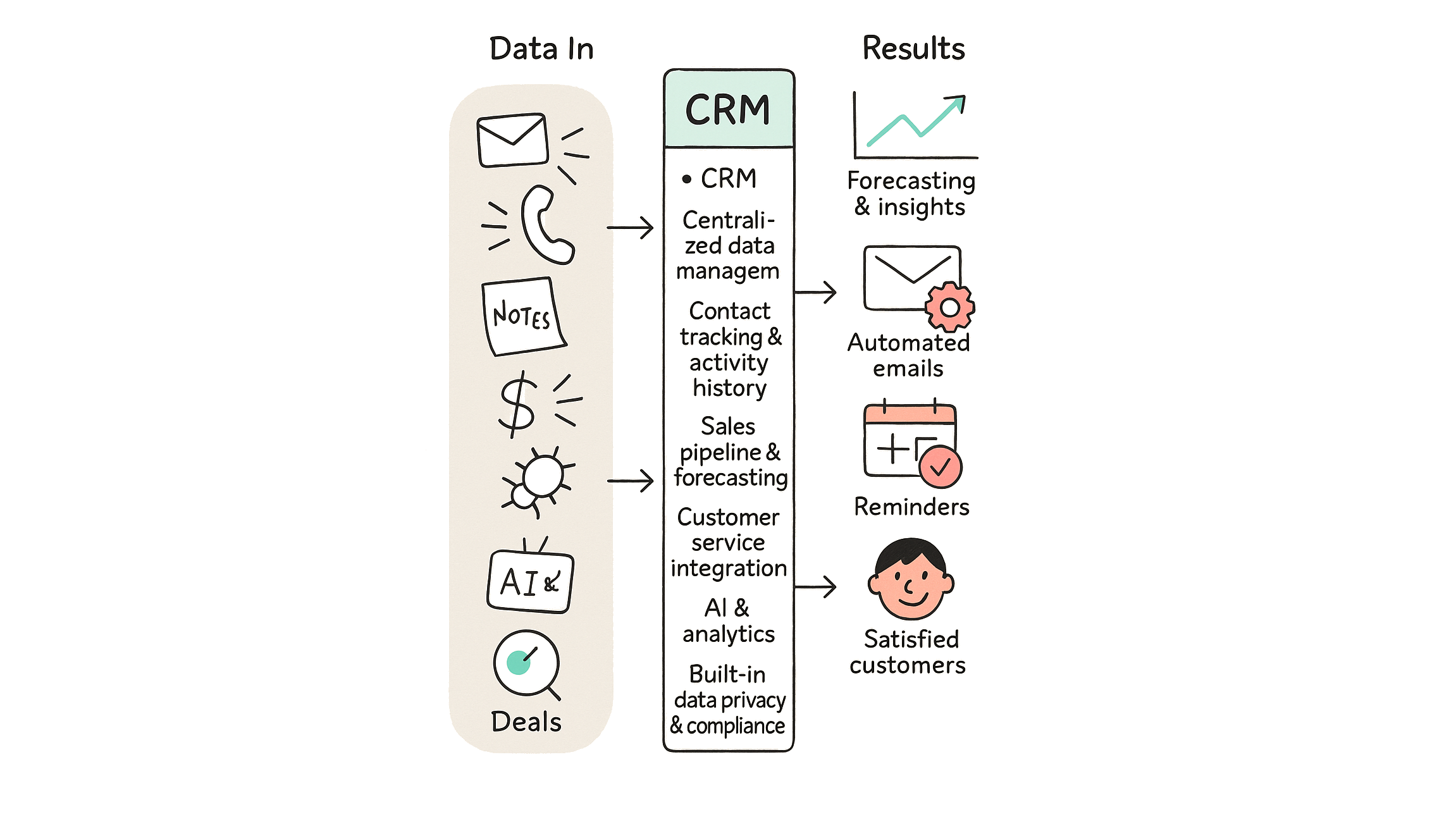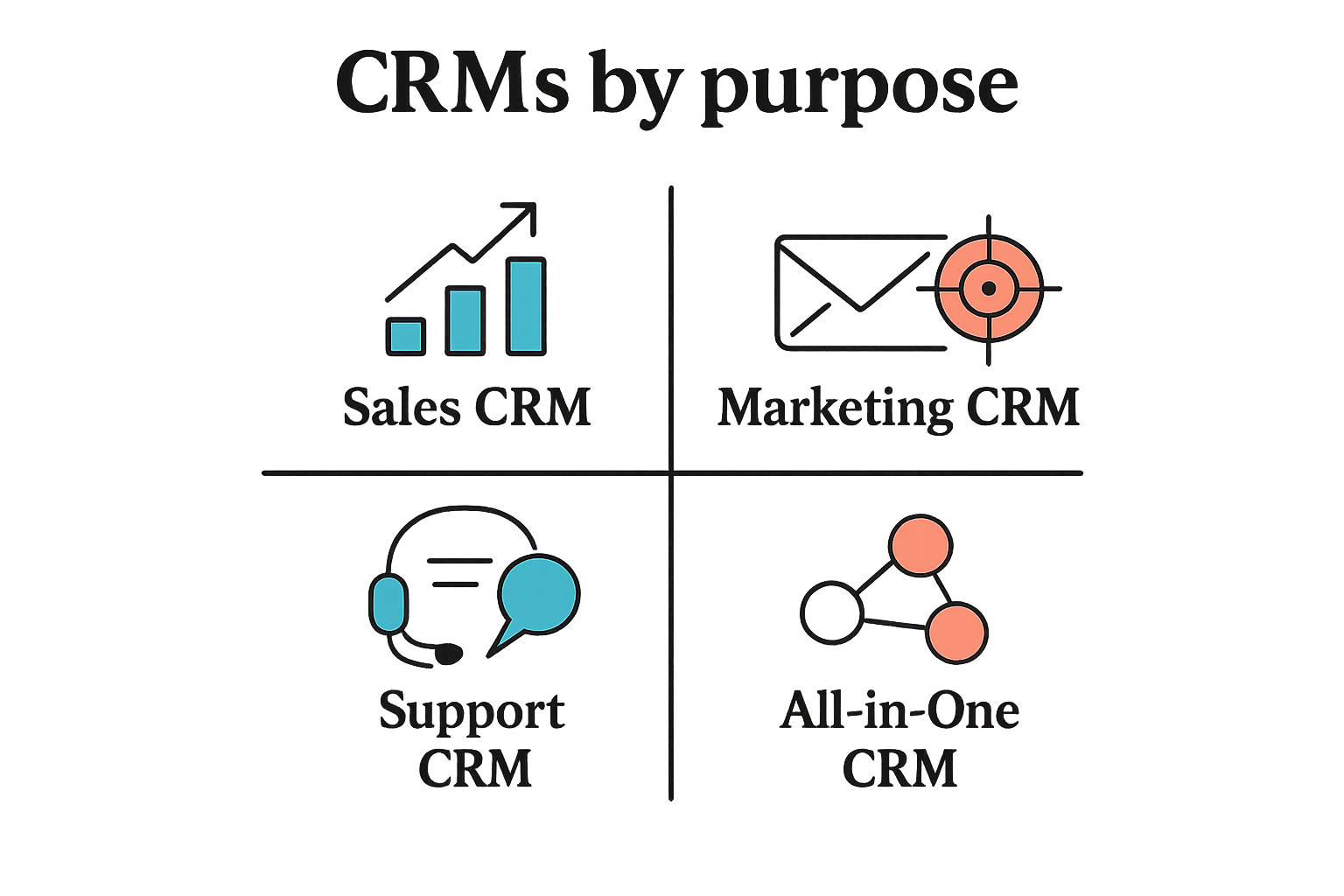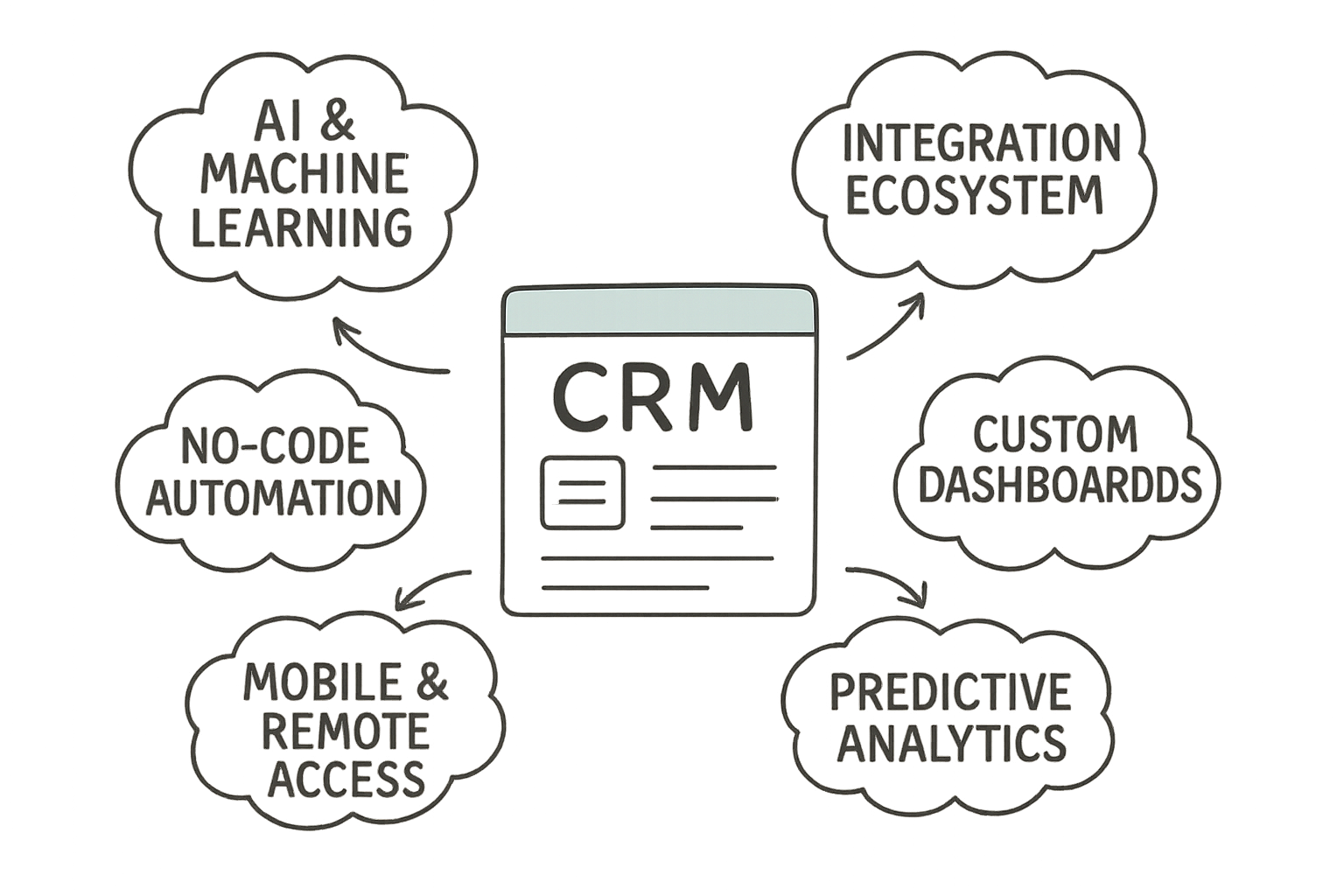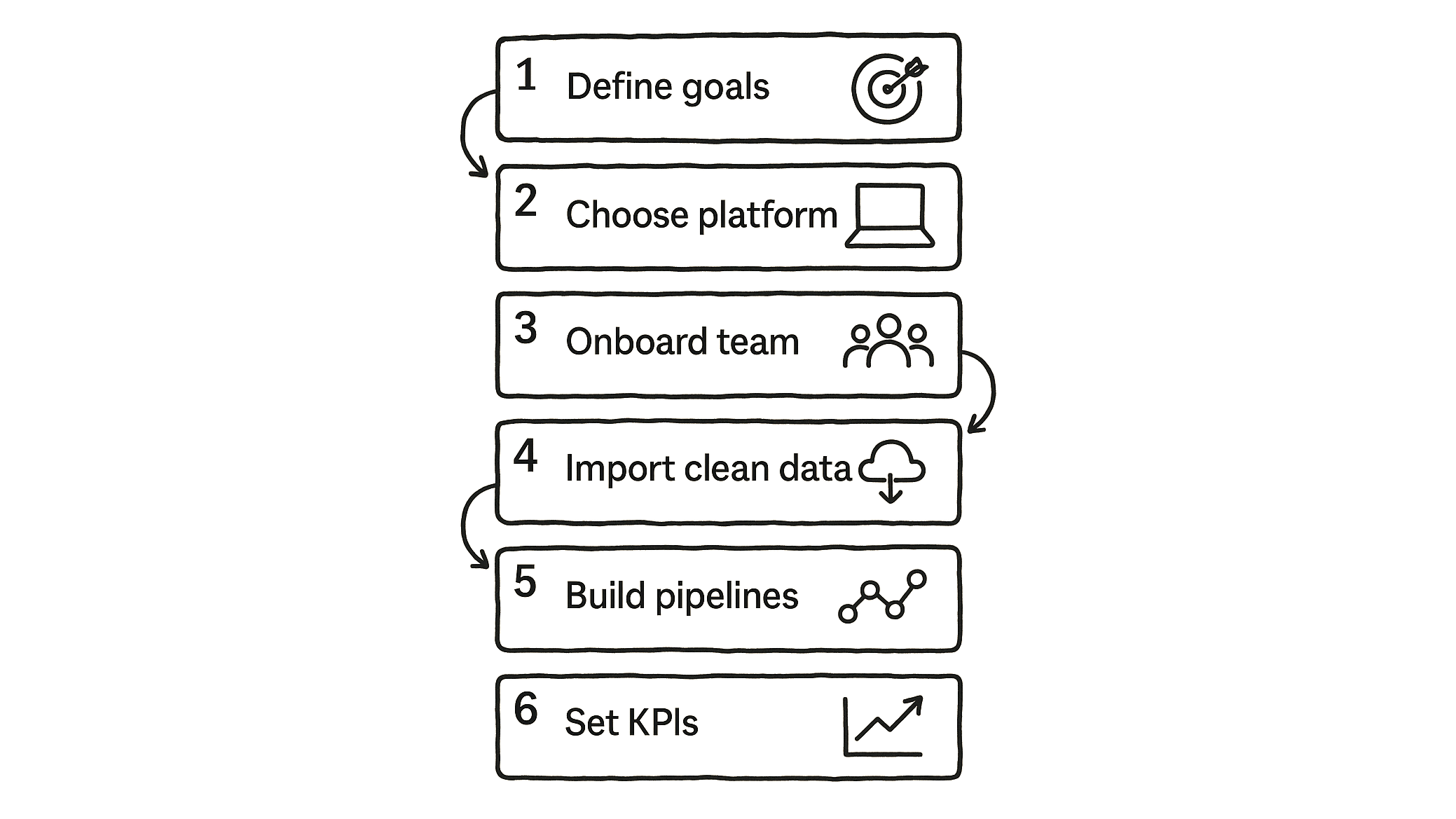What Is a CRM? (CRM Meaning, Definition & Examples)
TL;DR
• CRM stands for customer relationship management—both a strategy and the software that powers it.
• It keeps all your customer info, conversations, and sales tasks in one place.
• A good CRM helps you sell smarter, support better, and grow faster, with less manual work.
• It’s not just for big companies; startups, solopreneurs, and nonprofits use CRMs too.
Without a CRM, you’re probably juggling spreadsheets, sticky notes, and a few too many “just circling back” emails. It’s too easy for leads to go cold, deals to stall, and follow-ups to fall through the cracks. That all translates into lost revenue.
A CRM gives you one home for your contacts, conversations, and sales activity. If you want to scale without burning out your team, a CRM system is non-negotiable.
Keep reading to find out what is the purpose of CRM systems.
What is a CRM? (in plain English)
A CRM is software that helps you manage your relationships with customers and prospects.
Imagine your entire business memory: every lead, email, task, deal, support ticket, or follow-up, all in one place and updated automatically. That’s your CRM.
Think of it like a digital assistant crossed with a sales coach and a filing cabinet—one that never forgets a birthday, drops a lead, or misses a renewal.
And just to clarify:
- CRM (the strategy) = how you manage customer relationships to grow your business.
- CRM software = the tool that helps you do it consistently and at scale.
What does a CRM actually do?

A CRM keeps all your customer relationships in one place—and then quietly goes to work making every part of your business smoother.
It tracks who your customers are, what you’ve said to them, what they’ve bought (or haven’t), when to follow up, and what to do next. Whether you’re nurturing leads, closing deals, or handling support tickets, a CRM acts like your second brain: always organized, never forgetful.
Instead of bouncing between your email inbox, calendar, spreadsheets, and post-its, a CRM gives you one hub where everything connects. No more guessing who owns a lead, when a deal is due, or whether someone followed up.
Here’s what that looks like in action:
- Centralized data management: Every contact, account, deal, email, and note is stored in one searchable, permission-controlled system.
- Contact tracking and activity history: CRMs automatically log calls, emails, meetings, and notes, giving you a timeline view of every customer touchpoint. That means no more digging through inboxes or asking, “Who talked to this person last?”
- Sales pipeline + forecasting: Visualize deal stages, assign probabilities, set close dates, and forecast revenue accurately. It’s easier to spot bottlenecks when you can see exactly where deals slow down.
- Marketing automation: Build email sequences, trigger campaigns based on behavior, and send timely nudges like welcome or renewal emails
- Customer service integration: Connect support tickets, live chat, and call logs to customer records so customers never have to repeat themselves.
- AI and analytics: Get nudges when a deal’s gone quiet or a customer might churn. Some CRMs even recommend what to do next.
- Team collaboration: Assign tasks, leave internal notes, tag teammates, and control data visibility by role.
With a CRM, you’ll be able to always stay one step ahead and predict what your customers need without burning yourself out doing it manually.
What are the different types of CRM software?

Traditionally, there are four types of CRMs:
- Operational – Manages the day-to-day: lead capture, pipeline tracking, automated follow-ups, and keeping contact timelines current.
- Analytical – Turns customer data into insights for segmentation, trend spotting, and accurate forecasting.
- Collaborative – Keeps all departments on the same page with a shared view of the customer journey.
- Hybrid – Combines automation, analytics, and collaboration features into one platform.
But in practice, it’s often more helpful to think about CRMs by purpose, size, and industry.
CRMs by business size
- CRMs for startups can be used to track early conversations, nurture leads, and avoid duplicate outreach. When you’re wearing five hats, a CRM keeps your follow-ups from falling through the cracks.
- CRMs for small businesses are great for team alignment, so everyone sees the same deal flow, customer history, and task list.
- Enterprises use CRMs to manage complex sales cycles, global support teams, layered permissions, and deep forecasting across departments.
CRMs by purpose
Sales CRMs
Best for: Sales teams and managers who need to track deals and prioritize the right opportunities.
Sales CRMs centralize pipeline data, automate follow-ups, and highlight high-value leads—so reps spend time where it matters most.
Popular picks:
- Pipedrive – Visual deal pipelines with activity reminders to keep momentum.
- Close – Built-in calling, email, and SMS for faster outreach from one platform.
- Salesforce – Advanced lead scoring, forecasting, and customization for complex sales cycles.
Marketing CRMs
Best for: Marketing teams running targeted campaigns and nurturing leads across multiple channels.
Marketing CRMs are used to segment contacts, trigger automated campaigns, and track engagement, turning interest into measurable results.
Popular picks:
- ActiveCampaign – Email, automation, and lead scoring in a single platform.
- Zoho CRM – Integrated tools for segmentation and personalized outreach.
- Keap – CRM plus easy-to-build marketing workflows for small businesses.
Support CRMs
Best for: Customer service teams who need to resolve issues quickly and personally.
Customer service CRM systems log every interaction, flag high-value customers, and give agents full history for faster resolutions.
Popular picks:
- Zendesk – Ticketing, live chat, and knowledge base in one interface.
- Freshsales – Omnichannel support with automation and self-service portals.
- Help Scout – Email-based help desk that feels personal for smaller teams.
All-in-One CRMs
Best for: Businesses that want sales, marketing, and service in one system.
These CRM tools unify data, reduce tool switching, and ensure every team works from the same source of truth.
Popular picks:
- HubSpot CRM – Free core CRM with paid hubs for sales, marketing, and service.
- monday CRM – Customizable boards and workflows across departments.
- Bitrix24 – All-in-one CRM with project management, chat, and automation.
CRM by industry
- Finance & insurance teams use CRM tools for compliance tracking, client segmentation, and automated policy renewal workflows.
- Healthcare providers use healthcare CRM software to streamline patient outreach and manage relationships across providers, departments, and systems.
- Retail & ecommerce brands use CRMs to create personalized shopping experiences and re-engagement campaigns.
- SaaS companies use CRMs to reduce churn, track product usage, and surface upsell opportunities.
- Realtors and brokerages depend on real estate CRM platforms to capture leads from listings, automate follow-ups after showings, and manage closings from offer to contract.
- Automotive dealers and service centers use automotive CRM for timely service reminders, trade-in upgrade offers, and a complete record of every customer interaction.
No matter your size, industry, or role, if relationships are part of your business, a CRM helps you take better care of them.
Key benefits of CRM
At its core, a CRM helps you stop dropping the ball.
A CRM is your system of record, your follow-up assistant, and your sales coach all rolled into one. The best ones help you sell more, serve better, and scale without hiring five new people to stay on top of it all.
Here are the biggest benefits of using a CRM.

Improved customer retention
CRMs help you keep the customers you already worked so hard to win. You can set up automated reminders for quarterly check-ins, track service issues, and trigger win-back emails when engagement drops. Reps can see if a customer hasn’t opened emails in months—or if support tickets are piling up—and reach out before it’s too late.
You’re not guessing who’s drifting. You’re catching it early and acting on it.
Shorter sales cycles
When your CRM tracks every touchpoint—email opens, call logs, meeting notes—it’s easy to spot where a deal is stuck and what to do next. Built-in task reminders and lead scoring help reps prioritize the right conversations, while automations nudge deals forward (like sending proposals, follow-ups, or scheduling demos) without waiting.
Less time chasing info = more time closing.
Better team alignment
With shared contact timelines and task assignments, your whole team sees what’s happening, in real time. Sales isn’t blindsided when support steps in. Marketing doesn’t keep emailing someone who’s already closed. Everyone knows where the relationship stands—no shoulder taps or Slack messages required.
When everyone works from the same timeline, there’s no confusion about who’s doing what—or what happens next.
Real-time insights and dashboards
CRMs surface the metrics that matter: deal velocity, pipeline value, win rates, churn risk. Leaders get a live view of where revenue is coming from (or slipping away). Reps see how close they are to quota, and ops can spot patterns without exporting a single CSV.
No more “We’ll pull a report Friday.” The data is already there, and always current.
Automation that saves time and money
Instead of reps manually assigning leads or sending every follow-up email, CRMs can trigger actions based on rules. Example: A lead fills out a pricing form → it’s tagged “hot,” assigned to a rep, and receives a personalized intro email—all within seconds.
You create the playbook once. The CRM runs it for you, at scale.
Predictive customer behavior
Modern CRMs with AI analyze past data to predict what’ll happen next—like which deals are most likely to close, or which customers are at risk of churning. You can sort leads by likelihood to convert or get alerts when an account goes quiet after a strong start.
It’s not just tracking what happened—it’s helping you shape what happens next.
Scalable growth infrastructure
When your business doubles, your CRM doesn’t blink. Add more users, build new pipelines, set permissions, connect new apps—without duct-taping together a new system. CRMs also create repeatable systems so onboarding new reps doesn’t mean reinventing the wheel.
Instead of “we’ll figure it out later,” you’re building something that won’t break as you grow.
Cloud vs. On-Premise vs. Hybrid CRM
Choosing where your CRM lives—cloud, on-premise, or somewhere in between—shapes everything from how fast you launch to how much control you have. The right setup depends on your team, your tech stack, and how much ownership (or overhead) you want.
Here’s how each model stacks up:
Cloud CRM
Cloud-based CRM is hosted by the vendor. Access via browser or app.
- Pros: Fast setup, accessible from anywhere, automatic updates
- Cons: Monthly fees, data stored offsite, less backend control
- Best for: Small to mid-sized teams who want low maintenance and remote access
- Cost: Usually per user/month (e.g., $12–$50/user)
Example: You sign up for HubSpot CRM, log in from your browser, and your data’s ready to go, no IT required.
On-Premise CRM
Installed on your own servers. Full backend control.
- Pros: Full data ownership, no vendor lock-in, customizable
- Cons: Higher upfront costs, longer setup, IT required for maintenance and security
- Best for: Heavily regulated industries or orgs with internal IT teams
- Cost: One-time license + hosting + support (can exceed $10K+ annually)
Example: A healthcare provider installs Vtiger on local servers to meet internal data compliance rules.
Hybrid CRM
Mix of both. Some tools hosted, others on-site.
- Pros: Flexibility to keep sensitive data in-house while using cloud features
- Cons: More complex to manage; may require custom integrations
- Best for: Enterprises balancing compliance with collaboration
- Cost: Varies—usually custom-quoted
Example: A financial firm keeps client data on-prem, but uses cloud tools for sales and marketing.
Bottom line:
If you want speed and simplicity, go cloud. If data control and compliance matter more, on-premise gives you the reins. Hybrid works when you need both, but comes with tradeoffs. Choose the setup that fits your team’s bandwidth, risk tolerance, and roadmap.
What features to look for in 2025 CRM software
In 2025, a CRM should actively make your job easier. The best tools aren’t bloated with bells and whistles you’ll never touch. They quietly do the heavy lifting in the background, help you spot patterns you’d miss, and let your team move faster without working harder.
Here’s what actually matters.
AI and machine learning
CRMs now do more than store data—they analyze it. AI can surface your warmest leads, flag accounts at risk of churning, or suggest next-best actions based on what’s worked before. It’s not magic, but it’s close.
No-code workflow automation
You shouldn’t need a developer to set up a basic email sequence or follow-up reminder. Look for drag-and-drop builders that let you automate tasks, handoffs, and customer journeys in a few clicks.
Integration ecosystem
Your CRM should play nice with your existing tools—Gmail, Slack, Zoom, Stripe, QuickBooks, and more. Native integrations are ideal. Otherwise, look for Zapier support or open APIs.
Mobile and remote access
Field reps, hybrid teams, and on-the-go founders need full access from their phone—not a stripped-down app. Look for mobile CRM apps that actually work offline and sync back when reconnected.
Predictive analytics
Don’t just react—anticipate. Modern CRMs use historical patterns to forecast revenue, identify your most engaged contacts, and help teams stay proactive.
Custom dashboards and reporting
Every role needs a different view. Make sure your CRM lets you build dashboards that show your metrics (not just a default leaderboard). Bonus points for real-time updates and exportable reports.
Bottom line: If a CRM can’t save you time, show you what’s working, or grow with your team, it’s not the right fit.
How much does a CRM cost?
The short answer: it depends on what you need, how many people need access, and how far you want to go beyond the basics. There are free CRM plans and open source CRMs that won’t cost you anything. Others can rack up thousands a month. The key is knowing what you're actually paying for—and whether it's worth it.
Here’s how CRM pricing really works in 2025:
Common pricing models
- Per user, per month: Most CRMs charge by user seat. Expect anywhere from $10–$30/user for basic plans, up to $100+ for advanced features (like Salesforce, HubSpot Pro, or Zoho Enterprise).
- Tiered plans: Pricing scales with features. For example, email sync might be free, but AI forecasting or custom reporting might sit behind a paywall.
- Per feature/module: Some tools (especially open-source or industry-specific CRMs) let you pick à la carte modules. Great for tight budgets or niche workflows.
Watch out for “upgrade traps” where must-have features (like workflow automation or API access) only unlock in higher tiers.
Total cost of ownership (TCO)
CRM pricing isn’t just about subscriptions. Consider:
- Setup and onboarding time (especially for custom fields and automations)
- Data migration or cleaning tools
- Training and support (some platforms charge extra)
- Add-ons like dialers, forms, or integrations
Even "free" CRMs may cost time and effort to get running right.
What’s the ROI?
On average, businesses see $8.71 in return for every $1 spent on CRM, according to Nucleus Research. When implemented well, CRMs pay for themselves by:
- Saving hours per rep per week on admin
- Catching deals that would’ve slipped through
- Improving close rates and shortening sales cycles
- Increasing customer retention with better follow-up and support
How to successfully implement a CRM (step-by-step)
Even the best CRM won’t help if it’s just another tab no one uses. The difference between “we tried a CRM once” and “this changed how we work” comes down to how you roll it out.
Here’s a step-by-step roadmap on how to implement your CRM the right way, without overwhelming your team (or yourself):

1. Define your goals
Before you even pick a tool, get crystal clear on why you need a CRM. Are you trying to shorten sales cycles? Improve follow-ups? Track marketing ROI? This keeps you focused during setup and gives you a yardstick to measure success later.
Skip this step, and your CRM will turn into a digital junk drawer.
2. Choose your platform
Pick a CRM that fits your workflow, not the other way around. Need automation? Choose one with visual workflows. Heavy on Gmail? Pick a tool that lives in your inbox. Want pipeline views and task tracking? Prioritize that in your selection process.
3. Get team buy-in
Don’t spring it on your team like a surprise inspection. Involve key users early, show them how it’ll save time (not add work), and explain what’s changing. Assign an internal “owner” to keep things moving.
People don’t resist tools—they resist complexity with no apparent benefit.
4. Import and clean your data
Bad data = bad CRM. Before you migrate, scrub old contacts, remove duplicates, and structure your fields clearly. Most CRMs support CSV imports and offer basic deduplication, but it’s worth doing a pre-clean.
5. Build automation and pipelines
Don’t try to automate everything at once. Start small: a welcome email, a task reminder, a lead assignment rule. Then build out your deal stages and create pipelines that match how your team already works, not some idealized sales funnel.
6. Track KPIs early
What gets measured gets improved. Choose 3–5 metrics tied to your goals (e.g., time to first response, deals closed per month, customer follow-up rate). Most CRMs offer basic dashboards or custom reports to help you track progress from day one.
Pro tip: Run a short pilot with a small team before a full rollout. Test your workflows, tweak your fields, and get feedback. Then scale with confidence.
Examples of CRM software in action
The real power of a CRM lies in the results it drives when used well. These real-world examples show how businesses in different industries are closing more deals, serving customers better, and reclaiming time for higher-value work.
Using CRM to boost sales and pipeline activity (Zoho CRM → CIMCO Refrigeration)
CIMCO Refrigeration, North America’s largest industrial refrigeration contractor, needed to replace its outdated CRM (ACT!) to handle a growing sales team across 30 offices. Switching to Zoho CRM centralized data, standardized their sales pipeline, and gave managers clear visibility into performance.
Results:
- 20%+ boost in sales company-wide
- 25–30% increase in sales pipeline activity despite pandemic challenges
- Improved lead response times and employee retention through better training insights
- Reduced inefficiencies with automation, analytics, and third-party integrations (Zoho Marketing Automation, PandaDoc)
Using CRM to scale operations (AgencyBloc → The Brokerage, Inc.)
The Brokerage, Inc., a national insurance marketing organization, needed a better way to manage complex commission hierarchies and payment tracking for 31,000 agents. After switching to AgencyBloc, they automated commission processing, eliminated manual bottlenecks, and gained visibility into missed payments.
Results:
- 58% growth in agents and 34% growth in sales since adoption
- $40,000+ recovered in missing commissions from carriers
- $30,000+ saved annually on commission processing labor
- $10,000 saved annually by cutting 1–2 hours/day of manual follow-ups
Using CRM to improve customer service efficiency (Zendesk → Spoonflower)
Spoonflower, an online marketplace for custom fabrics and home décor, used Zendesk integrated with Forethought to overhaul their customer support. They replaced manual ticketing with AI-assisted triage, improved self-service options, and streamlined tagging to address recurring issues faster.
Result:
- 93% CSAT
- 85% one-touch ticket resolution rate
- 45% ticket deflection rate
- 9× higher chat conversion vs. standard site conversion
Using CRM to automate dispute resolution (Uber Eats → Salesforce Service Cloud)
Uber Eats’ merchant support teams were slowed by data spread across 30+ systems, leading to long resolution times for missing or incorrect orders. Consolidating data into a single Service Cloud view via MuleSoft and using Salesforce’s Einstein to surface context and predict case priority gave agents instant answers and automated many onboarding and follow‑up tasks.
Result:
- Cut merchant support systems from 30+ to 1
- Shortened dispute resolution times with AI-driven case triage
- Automated onboarding and 24/7 merchant self-service via Einstein Bots
- Standardized global support processes across 6,000+ cities
- Increased productivity by routing issues to the right agent instantly, reducing hand-offs and delays
Do you need a CRM? (Spoiler: yes)
If you’re managing more than 10 contacts and relying on your memory, your inbox, or a spreadsheet, you’re already overdue for a CRM.
CRM software gives you context for every conversation, keeps your team aligned, and automates the work you shouldn’t be doing manually. That means more time for selling, serving, and building trust, and less time chasing information.
Here’s what you need to do to get started.
- Get clear on your goals. Are you trying to shorten sales cycles, improve retention, or unify service? Your priorities should dictate your CRM choice.
- Test drive before you commit. Most platforms offer a free trial. Use it to set up real workflows, import sample data, and get your team’s feedback.
- Plan for adoption, not just purchase. A CRM only works if your team uses it. Budget time for training, data cleanup, and process tweaks.
And if choosing one feels overwhelming? You’re not alone. We can help you find the best-fit CRM for your team and budget.
Ready to keep learning? Read this next:
- How to Choose a CRM: 10 Expert Tips
- 7 CRM Best Practices in 2025
- CRM vs CMS: Differences Explained
- ERP vs CRM: Differences Explained




